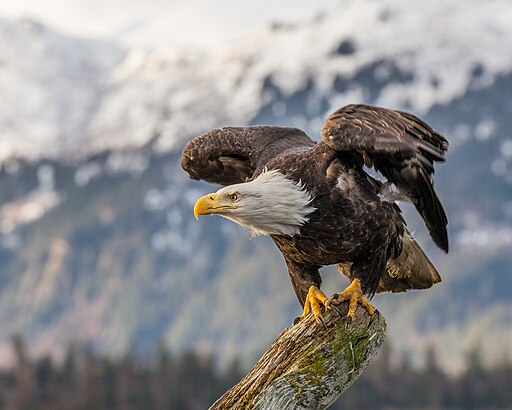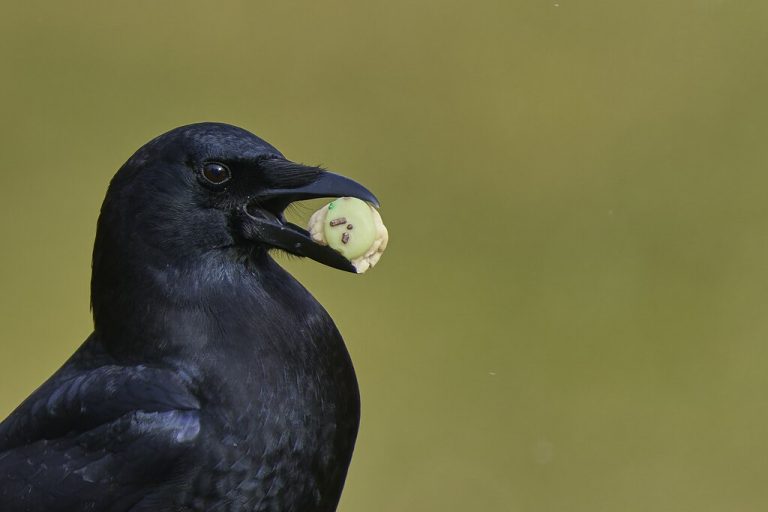Killdeer: Nature’s Master of Deception
Killdeer
Nature’s Master of Deception
Charadrius vociferus
ORDER: Charadriiformes
FAMILY: Charadriidae
Introduction
Few birds demonstrate the art of theatrical deception quite like the Killdeer (Charadrius vociferus), a widespread plover that has perfected the dramatic “broken-wing” display to protect its young. This conspicuous, double-banded species thrives in areas far from water, making it unique among shorebirds. With its loud, piercing call that gives it both its common and scientific names, the Killdeer has become one of North America’s most familiar and successful bird species (American Bird Conservancy, n.d.; Audubon, n.d.).
Myths and Legends
While comprehensive cultural mythology specific to the Killdeer is not extensively documented in ornithological literature, the bird’s distinctive characteristics have made it notable in human culture. Its name itself represents an onomatopoeia—a convention where something is named for its sound, literally “imitation of a sound” from the Greek. This naming tradition places the Killdeer alongside other birds like the Eastern Whip-poor-will, Chuck-will’s-widow, and Northern Bobwhite, all named for their distinctive calls (American Bird Conservancy, n.d.).
In earlier times, the Killdeer was also known as the Chattering Plover or the Noisy Plover, both nods to its vocal nature that eighteenth-century naturalists found particularly noteworthy (Cornell Lab of Ornithology, n.d.). These historical names reflect the bird’s long-standing relationship with human observers who have been impressed by its persistent vocalizations.
Classification
The Killdeer was first described in 1758 by Swedish naturalist Carl Linnaeus in the 10th edition of his Systema Naturae as Charadrius vociferus, its current scientific name. The genus name Charadrius is Late Latin for a yellowish bird mentioned in the fourth-century Vulgate Bible, deriving from the Ancient Greek kharadrios, referring to a bird found in ravines and river valleys. The specific name vociferus is Latin, coming from vox meaning “cry” and ferre meaning “to bear”—literally meaning “shouting” or “yelling” (Linnaeus, 1758).
Full Classification:
- Kingdom: Animalia
- Phylum: Chordata
- Class: Aves
- Order: Charadriiformes
- Family: Charadriidae
- Genus: Charadrius
- Species: Charadrius vociferus
Three subspecies are recognized, with C. v. vociferus being the nominate subspecies found in the United States (including southeastern Alaska), southern Canada, and Mexico.
Physical Characteristics and Identification
The Killdeer is the largest of the “ringed” plovers, measuring 9-11 inches (23-28 cm) in length with a wingspan of 59-63 cm and weighing between 72-121 grams. It is easily recognized by its two distinctive black breast bands—a feature that makes it the only North American plover with double breast bands (American Bird Conservancy, n.d.; Audubon, n.d.).
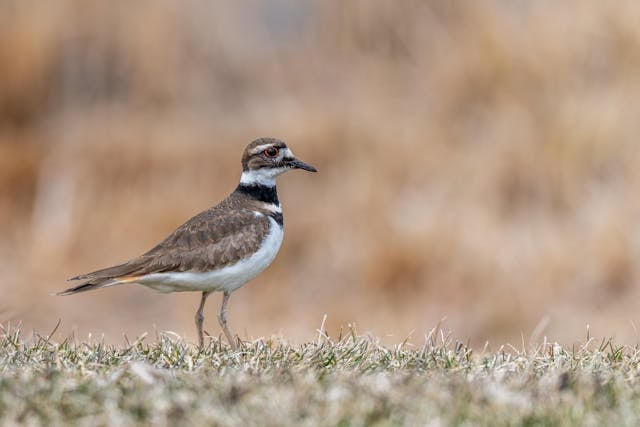
The bird displays brown upperparts with rufous fringes and white underparts. The head features patches of white and black, including a white forehead and a white stripe behind the eye. A bright red eye ring provides a striking accent to the facial features. The bird has a short, thick, dark bill and flesh-colored legs (Audubon, n.d.).
In flight, the Killdeer reveals its most dramatic feature: a brilliant orange-buff rump and tail that creates a conspicuous flash of color. The tail is primarily brown with a black subterminal band and white terminal band, while the wings show a white stripe at the base of the flight feathers (Cornell Lab of Ornithology, n.d.).
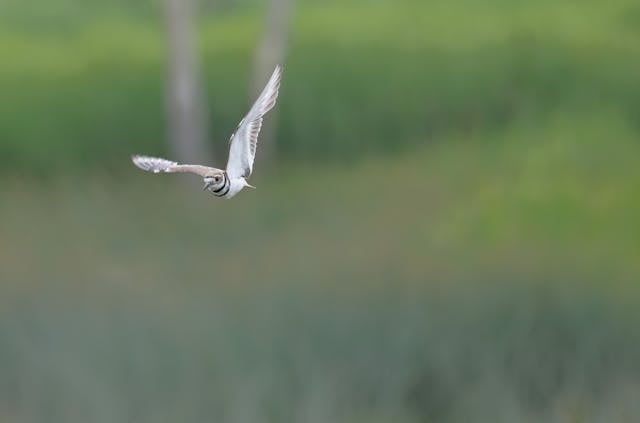
Juvenile Killdeer initially display only one breast band, which can lead to confusion with other plover species. They develop their second band as they mature. The female’s mask and breast bands tend to be slightly browner than those of the male (Audubon, n.d.).
Habitat and Distribution
The Killdeer is North America’s most widespread plover species, with a breeding range extending from southeastern Alaska and southern Canada throughout the United States to Mexico, with some populations reaching Panama. The species is a year-round resident in the southern half of its breeding range, including most of the contiguous United States. Caribbean populations, particularly in the West Indies, are also year-round residents (American Bird Conservancy, n.d.).
Unlike most shorebirds, Killdeer have adapted remarkably well to human-modified environments. They inhabit open areas with short vegetation (usually below 1 cm tall), including:
- Agricultural fields and pastures
- Golf courses and athletic fields
- Parking lots and airports
- Lawns and parks
- Gravel rooftops
- River banks and mudflats
- Coastal estuaries
This adaptability to human habitats has been key to the species’ success. Most successful nesting areas have some shallow water or other good feeding areas for chicks nearby (Audubon, n.d.; Cornell Lab of Ornithology, n.d.).
Northern populations are migratory, following a “leapfrog” pattern where they pass right over regions such as the southern U.S. where other Killdeer populations are nonmigratory. Wintering birds travel to Central America, the West Indies, and northern South America (American Bird Conservancy, n.d.).
Breeding, Family Structure, and Nesting Patterns
Killdeer engage in elaborate courtship displays that showcase their dramatic nature. During aerial displays, both birds hover high in the air or make short, butterfly-like flights on stiff wings with slow wingbeats, calling continuously. Ground displays involve both birds bowing to each other with fanned tails, revealing their bright orange-brown rumps and uppertail feathers (American Bird Conservancy, n.d.).
The nest itself is remarkably simple—a shallow depression or “scrape” in the ground, typically 3-3.5 inches across. Males and females participate in a “scrape ceremony” where the male lowers his breast and shapes the ground into a divot. If the female accepts, she approaches and takes his place on the scrape while the male puffs up and calls loudly (Audubon, 2021).

Nests are often placed on slight rises in open habitats with good visibility. After egg-laying begins, Killdeer frequently add light-colored materials such as white pebbles, shells, sticks, and even trash to the nest. Research suggests this preference for light-colored materials may help keep the nest cool or provide camouflage (Cornell Lab of Ornithology, n.d.).
The female typically lays four eggs (sometimes 3-5) that are buff-colored and heavily marked with black and brown spots, providing excellent camouflage. Both parents share incubation duties for 24-28 days. In very hot climates, adults shade eggs during mid-day and may soak their belly feathers to help cool the eggs (Audubon, n.d.).
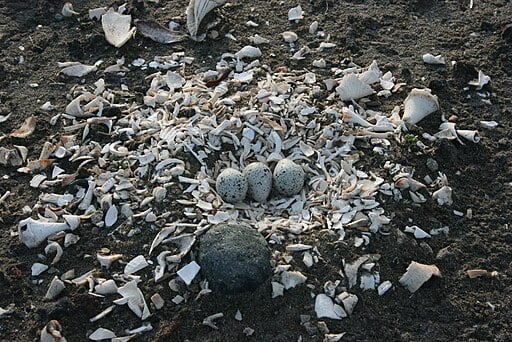
The precocial chicks are able to leave the nest soon after hatching, already covered in downy feathers with open eyes. Parents guide them to feeding territories, and while the young feed themselves, they may be tended by their parents for up to 10 days after fledging. Young birds achieve flight at approximately 25 days of age. In warmer parts of their range, Killdeer may raise two broods per year (Audubon, n.d.).
Intelligence and Behavioral Adaptations
The Killdeer’s most famous behavioral adaptation is its “broken-wing” distraction display, a sophisticated anti-predator strategy that has fascinated observers for generations. When a predator approaches the nest, the adult Killdeer performs an elaborate act, fluttering along the ground with one wing dragging, appearing severely injured. This display lures predators away from the nest, and once the threat is at a safe distance, the “injured” bird suddenly takes flight (American Bird Conservancy, n.d.; Audubon, n.d.).
Against large hoofed animals that might accidentally trample the nest, Killdeer employ a completely different strategy. They fluff themselves up, fan their tail over their head, and run directly at the intruder to change its path—a bold approach that demonstrates the bird’s ability to assess different threat types and respond appropriately (Cornell Lab of Ornithology, n.d.).
When foraging, Killdeer exhibit a characteristic stop-and-go pattern typical of plovers. They run a few steps, stop abruptly, and tilt their head to look and listen for prey before seizing the food with their bill. They also demonstrate learning behavior by following farm equipment like tractors and plows to catch prey turned up by the machinery (American Bird Conservancy, n.d.).
Remarkably, Killdeer chicks that nest on rooftops have been documented surviving falls from considerable heights—including one set of chicks that survived a leap from a seven-story building when lured off by their parents (Cornell Lab of Ornithology, n.d.).
Dietary Preferences
The Killdeer’s diet consists primarily of invertebrates, with these creatures making up more than 90 percent of their food intake. Their diverse menu includes:
- Beetles and flies (primary prey)
- Grasshoppers
- Earthworms
- Snails and millipedes
- Spiders
- Aquatic insect larvae
- Seeds (occasionally)
The species demonstrates opportunistic feeding behavior, occasionally taking tree frogs and dead minnows. Killdeer forage almost exclusively in fields, especially those with short vegetation and standing water. They show a preference for areas with cattle, which help maintain short vegetation suitable for foraging (American Bird Conservancy, n.d.; Audubon, 2021).
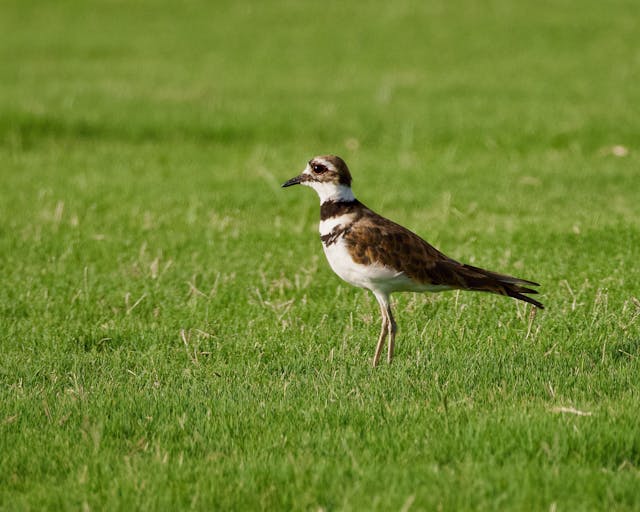
Killdeer employ various foraging techniques, including foot-stirring or patting the ground with one foot to stir up prey, and probing mud like a Semipalmated Sandpiper. Their visual hunting strategy is enhanced by their characteristic head-tilting behavior that helps them locate prey (American Bird Conservancy, n.d.).
Communication and Vocalization
The Killdeer lives up to its scientific name vociferus with an extensive and loud vocal repertoire. The bird’s common name comes from its distinctive call that sounds like “kill-deer” or “kill-dee,” often given in flight as the bird circles overhead on slender wings. This far-carrying call can be heard even after dark, making the Killdeer one of the more vocally active nocturnal shorebirds (American Bird Conservancy, n.d.; Audubon, n.d.).
Primary vocalizations include:
- The classic “kill-deer” or “kill-dee” call used for alerts, displays, and flight
- A rapid “dee-dee-dee” alarm call
- Prolonged chattering sequences when disturbed
Killdeer often serve as the first alarm system for other birds, giving prolonged chattering calls when predators or other threats approach. Their vocal nature earned them historical names like “Chattering Plover” and “Noisy Plover” from eighteenth-century naturalists who were impressed by their persistent vocalizations (Cornell Lab of Ornithology, n.d.).
The species is known to vocalize after the slightest disturbance and will call continuously during both aerial and ground courtship displays, making them one of the most vocally conspicuous birds in their habitats (Audubon, 2021).
Conservation Status
The Killdeer is currently classified as Least Concern by the IUCN and is considered one of the most successful shorebird species in North America. According to the North American Breeding Bird Survey, Killdeer populations declined by an estimated 0.57% per year between 1966 and 2019, resulting in a cumulative decline of about 26%. Despite this decline, Partners in Flight estimates the global breeding population at 2.3 million individuals and rates them 10 out of 20 on the Continental Concern Score, indicating a species of relatively low conservation concern (Cornell Lab of Ornithology, n.d.).
The species is protected under the American Migratory Bird Treaty Act of 1918 and the Canadian Migratory Birds Convention Act. The Killdeer’s success is largely attributed to its adaptability to human-modified habitats and willingness to nest close to people (Cornell Lab of Ornithology, n.d.).
However, this proximity to human activity creates specific threats:
Pesticide poisoning poses a major threat, as Killdeer frequently forage on lawns, golf courses, and agricultural fields that are often treated with toxic chemicals including neonicotinoids, chlorpyrifos, and glyphosate. These pesticides can cause direct mortality and also reduce insect prey populations (American Bird Conservancy, n.d.).
Collisions with vehicles, buildings, and towers represent another significant threat, particularly since Killdeer are attracted to gravel road shoulders and building pads for nesting (American Bird Conservancy, n.d.).
Habitat disturbance from mowing equipment can damage nests and kill or injure young birds. Conservation efforts include marking nesting areas as temporary “no-mow” zones during the breeding season (American Bird Conservancy, n.d.).
Despite these challenges, the Killdeer’s behavioral flexibility, broad habitat tolerance, and successful adaptation to human-modified landscapes have allowed it to maintain stable populations across most of its range.
Conclusion
The Killdeer stands as a testament to avian adaptability, thriving in an increasingly human-dominated world through a combination of behavioral flexibility, dramatic defensive strategies, and remarkable resilience. From its Oscar-worthy broken-wing displays to its successful colonization of golf courses and parking lots, this charismatic plover has demonstrated that coexistence with humans is possible when species can adapt to modified environments.
The bird’s loud, distinctive calls that echo across both natural and urban landscapes serve as a reminder of nature’s persistence in finding ways to thrive alongside human development. While the Killdeer faces challenges from pesticide exposure and habitat disturbance, its current stable population status offers hope that with continued awareness and simple conservation measures—such as temporary protection of nesting sites and reduced pesticide use—this remarkable species will continue to grace our fields, lawns, and shorelines for generations to come.
Understanding the Killdeer’s biology and behavior not only enriches our appreciation for this common yet extraordinary bird but also provides insights into how wildlife can successfully adapt to anthropogenic change. As we hear their piercing “kill-deer” calls ringing through the night or witness their dramatic distraction displays, we observe evolution in action—a species that has turned human proximity from a challenge into an opportunity.
References
American Bird Conservancy. (n.d.). Killdeer. Retrieved from https://abcbirds.org/bird/killdeer/
Audubon. (n.d.). Killdeer: Field guide. National Audubon Society. Retrieved from https://www.audubon.org/field-guide/bird/killdeer
Audubon. (2021). 10 fun facts about the Killdeer. Audubon Magazine. Retrieved from https://www.audubon.org/magazine/10-fun-facts-about-killdeer
Cornell Lab of Ornithology. (n.d.). Killdeer overview and life history. All About Birds. Retrieved from https://www.allaboutbirds.org/guide/Killdeer/
Linnaeus, C. (1758). Systema Naturae (10th ed.). Laurentius Salvius.
Nevada Department of Wildlife. (n.d.). Killdeer species profile. Retrieved from https://www.ndow.org/species/killdeer/

